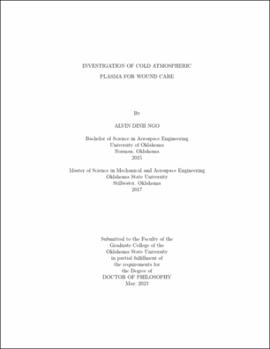| dc.contributor.advisor | Jacob, Jamey D. | |
| dc.contributor.author | Ngo, Alvin Dinh | |
| dc.date.accessioned | 2023-08-30T19:45:19Z | |
| dc.date.available | 2023-08-30T19:45:19Z | |
| dc.date.issued | 2023-05 | |
| dc.identifier.uri | https://hdl.handle.net/11244/339031 | |
| dc.description.abstract | Throughout the last decade, cold atmospheric plasma (CAP) has gained significant traction for aerospace and biomedical applications. The viability of CAP as a means for sterilization, and accordingly wound care, has made strides. There is a critical need for elucidation of the foundational mechanisms behind how CAP interacts with various cell types and surfaces to determine the pros, cons, and long-term viability of the technology for wound healing. In this study, a wound healing apparatus utilizing surface discharge actuators was designed and fabricated to perform laboratory testing. Pseudomonas aeruginosa (P. aeruginosa) and Methicillin-resistant Staphylococcus aureus (MRSA) were treated with CAP on plastic, glass, stainless steel, and aluminum and observed for differences in bacterial inactivation (BI) efficacy. BI testing resulted in stainless steel being more effective as a substrate for CAP treatment based on higher average absolute destruction of bacteria colonies. Two short studies on equine blood and mice skin were performed as a precursor and foundation for future studies that involve plasma x blood and plasma x skin interactions. Additionally, particle image velocimetry (PIV) was used to observe the flow field generated by the device for characterization and optimization of the flow. Several configurations and geometries, such as cylinders, threads, and meshes, were tested and observed for improvements in bacterial inactivation efficacy and mixing. The geometry and configuration of the plasma actuators were seen to have quantitative impacts in terms of BI efficacy and also showed high levels of form factor customizability of this technology. This study provides a wide breadth of preliminary research to lay the foundation for suggestions and recommendations for future research in CAP based wound care. | |
| dc.format | application/pdf | |
| dc.language | en_US | |
| dc.rights | Copyright is held by the author who has granted the Oklahoma State University Library the non-exclusive right to share this material in its institutional repository. Contact Digital Library Services at lib-dls@okstate.edu or 405-744-9161 for the permission policy on the use, reproduction or distribution of this material. | |
| dc.title | Investigation of cold atmospheric plasma for wound care | |
| dc.contributor.committeeMember | Elbing, Brian | |
| dc.contributor.committeeMember | Santhanakrishnan, Arvind | |
| dc.contributor.committeeMember | Ramachandran, Akhilesh | |
| osu.filename | Ngo_okstate_0664D_17968.pdf | |
| osu.accesstype | Open Access | |
| dc.type.genre | Dissertation | |
| dc.type.material | Text | |
| dc.subject.keywords | cold atmospheric plasma | |
| dc.subject.keywords | particle image velocimetry | |
| dc.subject.keywords | sterilization | |
| dc.subject.keywords | surface dielectric barrier discharge | |
| dc.subject.keywords | wound care | |
| dc.subject.keywords | wound healing | |
| thesis.degree.discipline | Mechanical and Aerospace Engineering | |
| thesis.degree.grantor | Oklahoma State University | |
